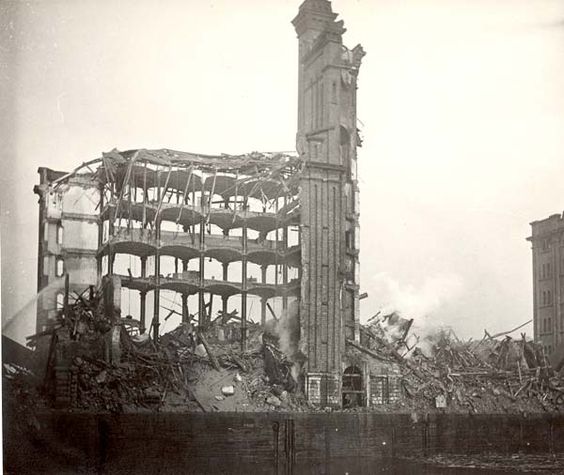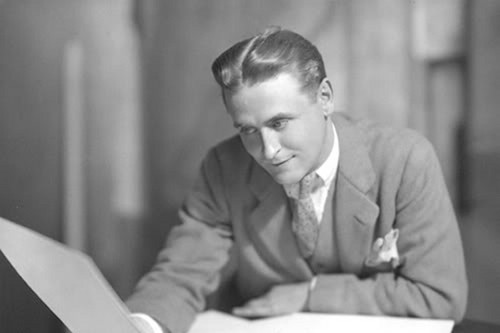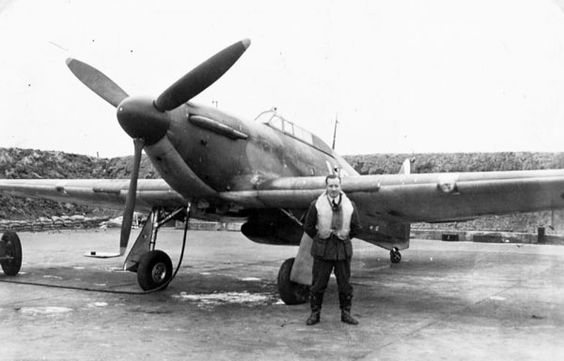Saturday 21 December 1940
 |
| Damage to Waterloo Dock, Liverpool after the bombing of 20/21 December 1940. |
I Corps, now comprising 2nd, 3rd and 4th Divisions, continues pressing up the heights that surround the town. The Greeks capture the heights of Tsipista northwest of the town, completing their removal of the Italian artillery. This forces the Italians, who have lost six artillery pieces, a mortar company, and other important equipment, to abandon the town during the night.
European Air Operations: The Luftwaffe attacks Liverpool and the Merseyside region again, badly damaging the docks and nearby warehouses. The manufacturing area of the city also receives extensive damage. The railway system is largely paralyzed by the attack. The Luftwaffe loses a Heinkel He 111 of 7,/KG 55 when it crashes upon returning to base in France.
The Italian Corpo Aereo Italiano chips in with its standard attack against Harwich.
RAF Bomber Command sends a small-scale raid against Berlin. The RAF also raids Porto Marghera, near Venice, hitting the docks and oil facilities.
 |
| The Leeds-Liverpool canal bank after the raids of 20/21 December 1940. |
Italian submarine Mocenigo attacks Convoy OG 47 in the Atlantic about 250 miles west of Freetown. There is only one escort, HMS Leith. The Mocenigo crew claims to have sunk three ships in the convoy, but the only known loss is 1253-ton Swedish freighter Mangen, which is hit at 21:17 with the second of two torpedoes (the other passes underneath the ship). Once hit, the Mocenigo goes under in three minutes and eight men perish. The Mocenigo later also shells 2473-ton British freighter Sarastone, a straggler from Convoy OG 47, which receives minor damage. The incident is odd because, despite the lack of other known ships lost in the convoy, two more explosions are heard in the dark - presumably other torpedoes that explode after they complete their runs. The survivors are lucky, as the convoy goes into emergency evasions immediately, but the rear ship on the port wing column, the Garm, luckily spots the lifeboats in the dark and picks them up.
The Luftwaffe raids on Liverpool continue to wreak havoc on shipping there. Two vessels are destroyed or sunk: HMS Maplin is set on fire, and 1293 ton British freighter Silvio sinks at the Alexandra Dock (one death). The damaged ships include 1777-ton British freighter Alpera, 5318-ton freighter City of Corinth, 5251-ton British freighter Demeterton, and 6256-ton Dutch tanker Onoba. Australian heavy cruiser HMAS Australia has a near-miss in dry-dock. Fortunately, when in harbor, most crewmen seek land shelters, though there are the occasional crews or crewmen that refuse to leave the ship - and pay the price.
In the River Mersey, 3071-ton British ferry Innisfallen hits a mine and sinks at the entrance to Canada Dock at Wirral Peninsula, Cheshire. There are four deaths, 216 survivors.
British 118 ton barge TIC.12 hits a mine and sinks. Everybody aboard survives.
Two tugs come to grief in the Thames Estuary. British 88 ton tug River Thames hits a mine and blows up. All the crew but one - the skipper - perish. British 196 ton tug Sun IX hits a mine and sinks between 1 and 2 Buoys, Yantlet Channel. There are three deaths.
German tug Anvers winds up on the rocks in the Chausey islands while ferrying across a barge from the mainland to the Jersey Channel Islands.
The Kriegsmarine lays a minefield, SWa, in the western part of the North Sea.
Convoy OB 262 departs from Liverpool, Convoy FN 364 departs from Southend, Convoys FS 366 and 367 depart from Methil.
Royal Navy anti-submarine warfare trawler HMS Cotillion is launched, and destroyer HMS Hursley is laid down.
U-651 launched, and U-173 and U-255 laid down.
 |
| Kapitänleutnant Joachim Schepke receives the Oak Leaves (only the 7th granted) to the Iron Cross, backdated to 1 December 1940. Nobody knows it, but Schepke already has sunk his last ship. |
Today, the two raiders journey to nearby Emirau and release prisoners from some of the ships they have seized. They disembark 343 Europeans and 171 Chinese and South Pacific natives. Emirau is inhabited by two European families, but they do not have a radio. Instead, they send a canoe to Kavieng in New Ireland so that the Australian government can take their new guests off their hands. The Orion keeps 150 prisoners because its captain reasons that the British need the sailors as badly as ships.
After depositing their prisoners on the island, Orion sails to Lamutrik and then Maug in the Mariana Islands for an engine overhaul. Supply ship Kulmerland, which has been tagging along to house some of the prisoners, heads off to re-supply at Japan. Komet remains in the vicinity, continuing to plot ways to disrupt Nauru's phosphate trade, which is virtually the only worthwhile Allied target for it in the Pacific Ocean region aside from shipping.
 |
| Cartoon character "Blabbermouse" in "Shop, Look and Listen," his second and final appearance for Warner Bros. in the Merrie Melodies series (Warner Bros). |
Royal Navy aircraft carrier HMS Illustrious, in Operation MC 2, sends nine Swordfish of RAF No. 815 and 819 Squadrons against an Italian convoy east of the Kerkennah Islands. They sink 1926-ton Peucenta and 6511-ton freighter Norge. The Luigi Rizzo also is hit but makes it to port. The Italian escort shoots down one of the Swordfish, killing the three crew.
Convoy MG 1 departs Malta bound for Malta, escorted by battleship HMS Malaya and eight destroyers. Several empty merchant ships that have been waiting there for the opportunity finally get away from Malta in this convoy.
German/US Relations: In a quote picked up by press agencies around the world, a German Foreign Ministry spokesman at the Wilhelmstrasse calls President Roosevelt's Lend-Lease idea, first floated by him only days before at a press conference, part of a policy of "pinpricks, challenges, insults, and moral aggression." Such a policy, he adds, is "insupportable," but everyone knows there is nothing to deter the United States from doing everything it wants to do to support England, short of an outright German declaration of war.
 |
| Gadsden, Alabama, 21 December 1940. People are getting in their last Christmas shopping (John Vachon, Library of Congress). |
Terboven simply makes clear in his letter that Norway is no longer an independent country and is under military rule. This really does not surprise anyone, but it gives the Norwegian Justices the impetus to make a big decision. The Justices send Terboven a resignation letter which states:
[T]he courts have, under Norwegian constitutional law, a duty to review the validity of laws and regulations.... We cannot conform to the view of judicial power expressed in the Reichskommisar's letter without violating our duties.(Former) Norwegian Chief Justice Paul Berg becomes a leading figure in the resistance movement after resigning.
US/Vichy France Relations: U.S. chargés d'affaires to the Vichy French government Robert D. Murphy and French General Maxime Weygand, Delegate-General to the North African colonies, meet in Dakar, Senegal. The Americans believe that Weygand is a good political alternative to both Marshal Henri Petain and Charles de Gaulle, neither of whom is looked upon with much favor in Washington. This is the beginning of extensive American meddling in murky Gallic politics during the war.
US/Chinese Relations: Claire Chennault, an air advisor to the Chinese Nationalist leader Chiang Kai-shek, and T.V. Soong meet with Secretary of the Treasury Henry Morgenthau. They brainstorm how to form fund an American Volunteer Group in China to help fight the Japanese - with whom the US is not at war. This meeting will lead eventually to the famous Flying Tigers.
Swiss/Soviet Relations: The Swiss government severs diplomatic ties with the Soviet Union.
US Military: Captain Richmond Kelly Turner, director of war plans for the US Navy, completes WPL-44 (Navy Rainbow Three). This plan for the first time institutes a "Germany first" policy within the US military, relegating the Pacific theater to a defensive posture should the US find itself at war with both Germany and Japan. Essentially, US naval forces would adopt a defensive posture in case of aggression by the Japanese and shift resources to the Atlantic.
The army hates this plan, partly because this was purely a naval staff planning exercise and they were not consulted - and never, ever discount the importance of inter-service rivalries. However, the army generals do have some grounds for objecting. Recall that the US Army still controls the air force (the US Army Air Corps), so it does have ways (in theory) of taking the war to Japan immediately from bases in the Philippines and Guam. However, Naval Secretary Knox approves the plan - and it is difficult to believe that Rainbow 3 was not at least in concept all or partly his idea in the first place. Some feel in 1940 and afterward that the US would be quite capable of offensive action against Japan upon the outbreak of war. This theory will be put to the test in almost exactly one year as if it were a laboratory experiment. A definitive answer will result.
Rainbow 3 is an interim plan, and planners from both the army and navy immediately begin working together on a new plan that will become Rainbow 5 in the spring of 1941. Somewhat ironically, it is the US Navy that later will raise Winston Churchill's ire by prioritizing the Pacific Theater of Operations.
Separately, the US Marine Corps 7th Defense Battalion completes its move to Pago Pago, Tutuila, American Samoa.
British Government: Prime Minister Winston Churchill travels to Shell Mex House in The Strand to meet with Sir Andrew Duncan of the Ministry of Supply. Among other things, they review Britain's supplies of mustard gas, the offensive chemical used during World War I with great lethal effect but subsequently banned. Britain, he learns, has 1485 tons of mustard gas, and 650 additional tons is being produced.
 |
| F. Scott Fitzgerald passes away on 21 December 1940. |
"Frenesí" (Spanish for frenzy), recorded on 3 March 1940 by Artie Shaw and his orchestra with an arrangement by William Grant Still, hits No. 1 on the Billboard pop chart. The song remains there for 13 weeks and on the charts for 23 weeks altogether. It is the second most popular song of 1940 and also one of the most remembered songs of the war years by American servicemen.
Warner Bros. releases "Shop, Look and Listen" (a variation on the well-known railroad expression "Stop, look, and listen"). This is the second and last cartoon to feature the character Blabbermouse. Voiced by Mel Blanc, Blabbermouse never catches on with audiences.
Future History: Frank Vincent Zappa is born in Baltimore, Maryland. Frank starts out in the school band as a drummer, then develops a somewhat unique fascination with the music of classical composer Edgard Varèse. While at Antelope High School, Frank meets Don Vliet (born on 15 January 1941), and they become close friends. Frank begins composing rock music while still in school, and after graduation writes and produces songs for other local artists. Joining a local band known as the Soul Giants, Zappa catches on as co-lead singer, and the band changes its name first to Mothers, and then to Mothers of Invention. After the band disbands, Frank becomes a successful solo musician, reforms the band, and becomes one of the top musicians of the era, along with Don Vliet, who adopts the name "Captain Beefheart." Frank Zappa passes away in 1993.
 |
| Baked Alaska in a shelter - The New Yorker, 21 December 1940. |
December 1, 1940: Wiking Division Forms
December 2, 1940: Convoy HX 90 Destruction
December 3, 1940: Greeks Advancing
December 4, 1940: Italian Command Shakeup
December 5, 1940: Thor Strikes Hard
December 6, 1940: Hitler's Cousin Gassed
December 7, 1940: Storms At Sea
December 8, 1940: Freighter Idarwald Seized
December 9, 1940: Operation Compass Begins
December 10, 1940: Operation Attila Planned
December 11, 1940: Rhein Wrecked
December 12, 1940: Operation Fritz
December 13, 1940: Operation Marita Planned
December 14, 1940: Plutonium Discovered
December 15, 1940: Napoleon II Returns
December 16, 1940: Operation Abigail Rachel
December 17, 1940: Garden Hoses and War
December 18, 1940: Barbarossa Directive
December 19, 1940: Risto Ryti Takes Over
December 20, 1940: Liverpool Blitz, Captain America
December 21, 1940: Moral Aggression
December 22, 1940: Manchester Blitz
December 23, 1940: Hitler at Cap Gris Nez
December 24, 1940: Hitler at Abbeville
December 25, 1940: Hipper's Great Escape
December 26, 1940: Scheer's Happy Rendezvous
December 27, 1940: Komet Shells Nauru
December 28, 1940: Sorge Spills
December 29, 1940: Arsenal of Democracy
December 30, 1940: London Devastated
December 31 1940: Roosevelt's Decent Proposal
2020








